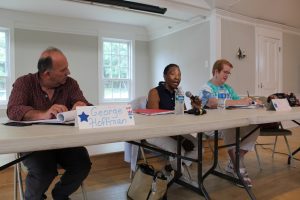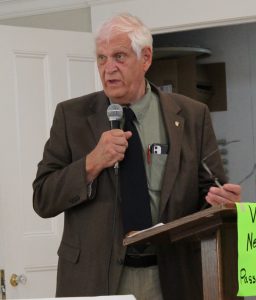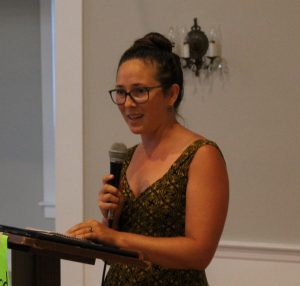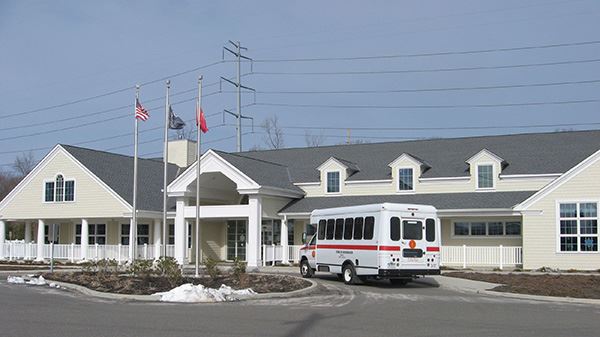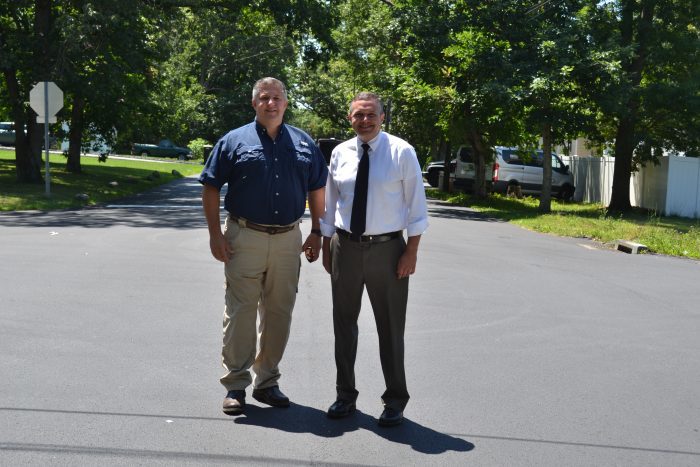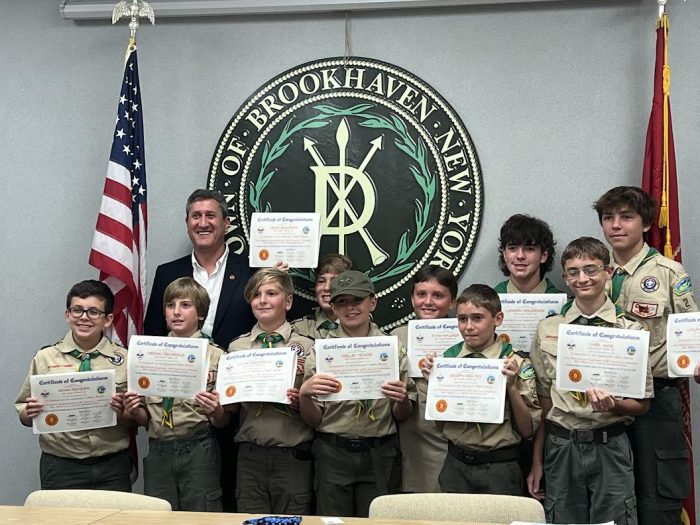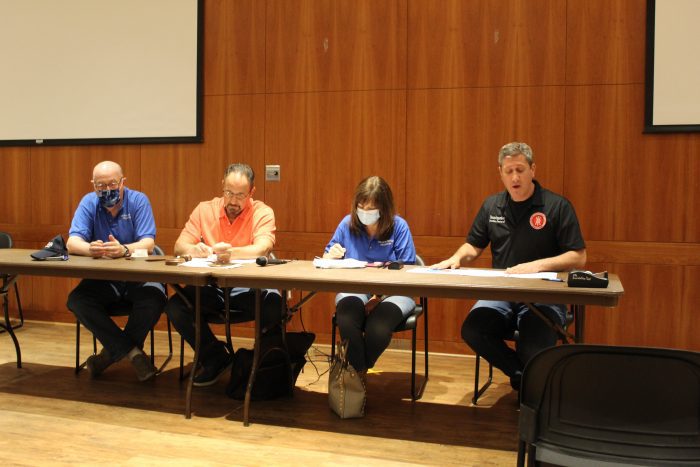For the second consecutive week, the Port Jefferson Station/Terryville community gave a strong display of community solidarity, this time during a public meeting at Brookhaven Town Hall on Thursday, Aug. 11.
Joined by neighbors from around the township, residents spoke out against two proposed maps for the redistricting of Brookhaven Town Council. If approved, the proposed maps would make significant changes to the existing boundaries of Council Districts 1 and 2, severing large chunks of Port Jefferson Station from Terryville and cutting Mount Sinai in half.
Public comments
Logan Mazer, a Coram resident, has proposed an alternative to the maps on the redistricting committee’s website. He told the Town Board that the only two districts requiring change are Districts 2 and 6 — the former being underpopulated and the latter being overpopulated. Because the two districts share a border, Mazer proposed the simple transfer of territory from District 6 into District 2 to correct the population imbalance.
The map of least change “doesn’t really change the political alignment … it doesn’t produce any gerrymandered districts and it protects communities of interest that are being carved up in these new maps for no discernable reason,” Mazer said.
Throughout the evening, Mazer’s map received favorable reactions from those in attendance. Among the supporters of the Mazer map is Lou Antoniello, a member of the Port Jefferson Station/Terryville Civic Association, who considered the draft proposal a way to transfer the burden of costs and maintenance into District 1.
“They showed that there was a portion of Mount Sinai — a beautiful section down by Cedar Beach and the surrounding community — which is a high-maintenance area for Mount Sinai that would be swapped out for the relatively self-sufficient area of Terryville,” he said. “I am here tonight to tell you that I don’t think that map is a map that should be voted on.”
Joan Nickeson, a Terryville resident and community liaison for the Port Jefferson Station/Terryville Chamber of Commerce, discussed the phenomenon of cracking, a practice in political redistricting that dilutes the voting power of an area by distributing its population across districts.
“It is unconscionable that you would crack our high school from the rest of its district, and crack neighbor from neighbor, and actually cleave members of the chamber of commerce from the chamber of commerce office,” she said. Addressing the board, she added, “I want you to remember to keep [the] 11776 [zip code] together when you go to vote.”
Paul Sagliocca, also a member of PJSTCA, shared the historic neglect of PJS/Terryville. He said that recently, the community has begun to counteract that narrative, introducing a Shakespeare in the Park event at the Chamber Train Car Park and building momentum for positive changes to the area.
Sagliocca asked that the board not impede the development of the area by dividing community members across political boundaries. “It is on the up — we do not need to be divided,” he said. “I would really wish that when it comes time to vote, that Port Jeff Station/Terryville stays in one solid community within District 1.”
Francis Gibbons, a Port Jefferson Station resident and member of the PJSTCA, said the redistricting process has diminished the public’s faith in its institutions. “Why are we continuing with this farce?” he asked. “I believe disenfranchisement brings with it a lack of political faith in our system. When you have a lack of faith, after time it brings civil war.”
Community members were joined by allies from the village of Port Jefferson. Bruce Miller, a former trustee of Port Jefferson Village, criticized the process. He considered the multiple cancellations of public hearings in CD1 as a way to silence the public.
Miller also suggested that the proposed maps fail to advance the interests of the town. “Just leaving Mount Sinai and Port Jefferson Station and Terryville the way they are seems to be a more appropriate strategy,” he said. “All this straining, all these machinations, result in small gains but are a bad look that angers the public needlessly.”
Also attending was Port Jeff Village trustee Rebecca Kassay. Speaking on her own behalf, Kassay told the Town Board that plans to divide Port Jefferson Station/Terryville would impair the village’s own efforts to revitalize its uptown areas.
Citing her history of coordinating with the PJS/T chamber of commerce and the civic association, the village trustee said, “To see the work slowed at all by political lines, by having these two communities needing to go to two different councilmembers, that would surely slow down the work and the progress of the area at large.”
Kassay also described how a breakdown in procedure can alienate ordinary citizens from the political process, leading to cynicism and distrust of their elected officials.
“There are people who truly believe that all politicians get into office and then they serve themselves or they serve their parties, and I don’t want that to continue,” she said. “I want all elected officials to stand up and make decisions and show their allegiance to their constituents and not their party.”
Supervisor’s reply
Following the public comments, Brookhaven Town Supervisor Ed Romaine (R) responded to those in attendance. He thanked the residents for coming out and for expressing their opinions. The supervisor affirmed his trust in the Town Board to listen carefully to constituent concerns.
Romaine also discussed the criteria that he will use to evaluate the proposed maps, saying that he favors a map that offers fewer “splits” of communities of interest.
“As supervisor, I’m going to tell you, I’m going to be looking for a map with less splits,” he said. “Your comments were very helpful. We’re looking for less splits.” Referring to his colleagues on the Town Board, the supervisor added, “I think they’ll sit down and they’ll take all the comments that you said … and they will consider all of them.”
The next meeting of the Brookhaven Redistricting Committee is scheduled for Tuesday, Aug. 16, at 6 p.m. at Comsewogue Public Library, 170 Terryville Road, Port Jefferson Station, NY 11776.








